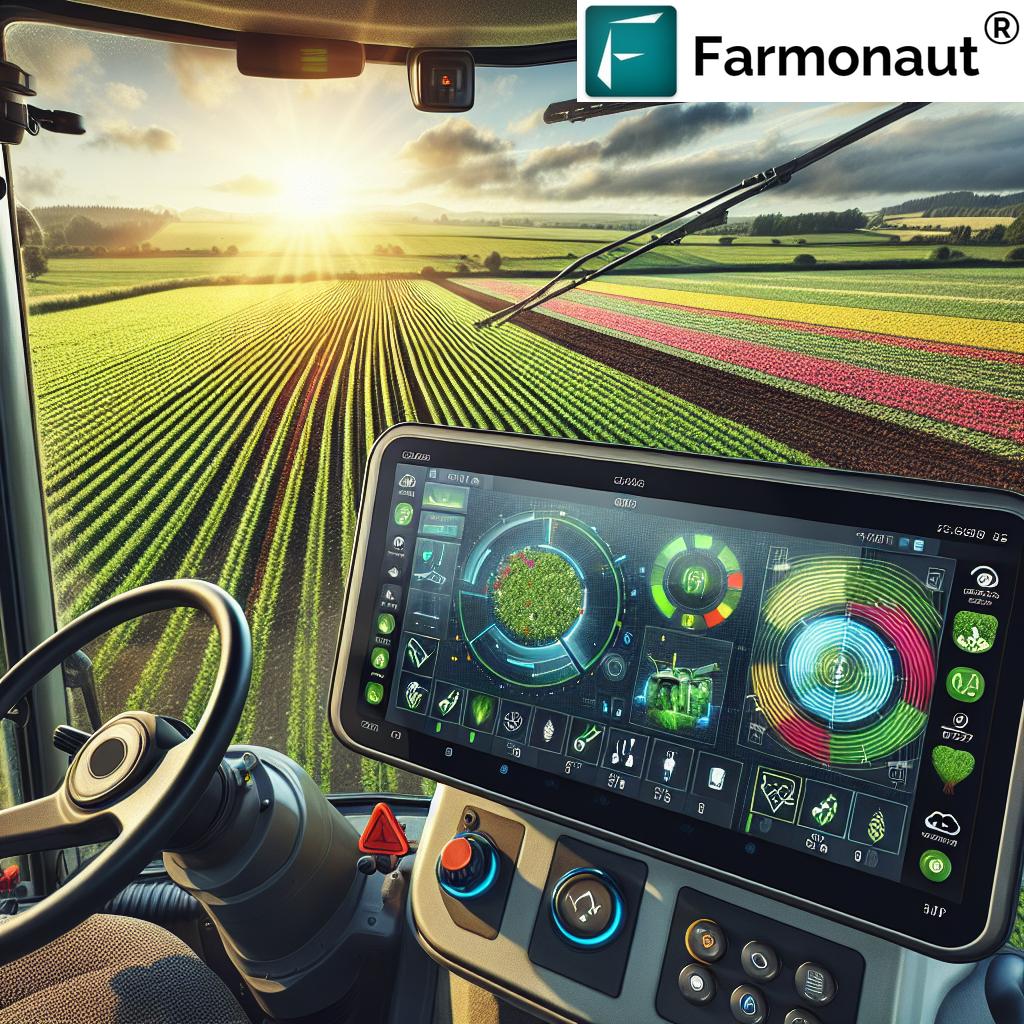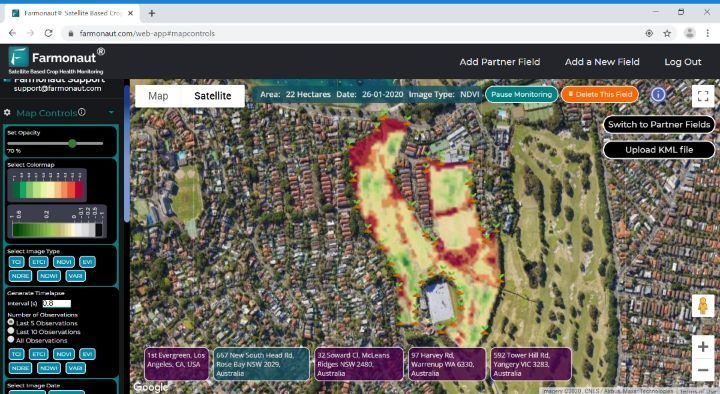Hyperlocal Weather Forecasting: Revolutionizing Crop Management and Pest Control for Efficient Agriculture

In the ever-evolving world of agriculture, we at Farmonaut are at the forefront of technological advancements that are transforming the way farmers manage their crops and combat pests. Our innovative approach to hyperlocal weather forecasting is revolutionizing crop management and pest control, leading to more efficient and sustainable agricultural practices.
The Importance of Accurate Weather Forecasting in Agriculture
Weather plays a crucial role in agriculture, influencing every aspect of crop growth and development. Accurate weather forecasts are essential for farmers to make informed decisions about:
- Planting and sowing dates
- Irrigation scheduling
- Fertilizer application
- Pest and disease management
- Harvesting times
Traditional weather forecasting methods often lack the precision needed for effective farm management. This is where our hyperlocal weather forecasting technology comes into play, offering farmers unprecedented accuracy and granularity in weather predictions.
Understanding Hyperlocal Weather Forecasting
Hyperlocal weather forecasting refers to highly localized and precise weather predictions for specific areas, often as small as individual fields. This level of detail is achieved through a combination of advanced technologies:
- Satellite imagery
- Ground-based weather stations
- Sophisticated weather models
- Artificial intelligence and machine learning algorithms
By integrating these technologies, we can provide farmers with accurate forecasts for temperature, humidity, wind speed, precipitation, and other critical weather parameters at a field-specific level.
The Impact of Hyperlocal Weather Forecasting on Crop Management
1. Optimized Irrigation Planning
One of the most significant benefits of hyperlocal weather forecasting is its impact on irrigation planning. With precise predictions of rainfall and evaporation rates, farmers can:
- Schedule irrigation more efficiently
- Avoid overwatering or underwatering crops
- Conserve water resources
- Reduce energy costs associated with irrigation
Our system takes into account factors such as soil moisture levels, crop type, and growth stage to provide tailored irrigation recommendations, ensuring optimal water usage throughout the growing season.
2. Improved Fertilizer Application
Accurate weather forecasts allow farmers to time their fertilizer applications more effectively. By applying fertilizers when conditions are optimal, farmers can:
- Maximize nutrient uptake by plants
- Reduce nutrient runoff and environmental impact
- Improve crop yields
- Lower fertilizer costs
Our system provides recommendations for the best times to apply fertilizers based on weather conditions, soil moisture, and crop growth stage.
3. Enhanced Pest and Disease Management
Pests and diseases can devastate crops if not managed properly. Hyperlocal weather forecasting plays a crucial role in effective pest and disease management by:
- Predicting conditions favorable for pest and disease outbreaks
- Optimizing the timing of pesticide applications
- Reducing unnecessary pesticide use
- Improving the effectiveness of integrated pest management strategies
Our system uses weather data along with pest and disease models to alert farmers to potential risks and provide guidance on preventive measures.
4. Optimized Planting and Harvesting Schedules
Timing is critical in agriculture, especially when it comes to planting and harvesting. Hyperlocal weather forecasts help farmers:
- Determine the best time to plant crops based on soil temperature and moisture conditions
- Plan harvesting activities to avoid adverse weather conditions
- Maximize crop quality and yield
- Reduce post-harvest losses
Our system provides farmers with customized planting and harvesting recommendations based on crop-specific requirements and local weather patterns.
Advanced Features of Our Hyperlocal Weather Forecasting System
1. Growing Degree Days (GDD) Calculation
Growing Degree Days (GDD) is a measure of heat accumulation used to predict plant and pest development rates. Our system calculates GDD based on hyperlocal temperature data, allowing farmers to:
- Predict crop growth stages more accurately
- Time management activities such as fertilizer application and pest control more effectively
- Estimate harvest dates with greater precision
By providing accumulated GDD information, we help farmers make more informed decisions throughout the growing season.
2. Crop-Specific Weather Models
Different crops have varying sensitivities to weather conditions. Our system incorporates crop-specific weather models that take into account the unique requirements of various crops, including:
- Temperature thresholds for growth and development
- Moisture requirements at different growth stages
- Sensitivity to extreme weather events
These models allow us to provide tailored recommendations for crops such as corn, soybeans, wheat, and even specialty crops like grapes.
3. Pest and Disease Forecasting
Our system goes beyond basic weather forecasting to include predictive models for pest and disease outbreaks. By combining weather data with information on pest life cycles and disease development, we can:
- Alert farmers to potential pest infestations before they occur
- Predict the spread of crop diseases
- Recommend optimal times for preventive measures or treatments
This proactive approach helps farmers stay ahead of potential threats to their crops, reducing the need for reactive and often more costly interventions.
4. Integration with Satellite Imagery
Our hyperlocal weather forecasting system is enhanced by integration with satellite imagery, allowing us to:
- Monitor crop health and development
- Detect anomalies in field conditions
- Provide more accurate estimates of soil moisture and evapotranspiration
This integration of weather data with satellite imagery provides farmers with a comprehensive view of their fields, enabling more informed decision-making.
Case Studies: The Impact of Hyperlocal Weather Forecasting on Different Crops
Corn Production
In corn production, timing is crucial for activities such as planting, fertilizer application, and pest control. Our hyperlocal weather forecasting system has helped corn farmers:
- Optimize planting dates based on soil temperature and moisture conditions
- Improve nitrogen application timing, reducing losses and improving yields
- Predict and manage pest pressures more effectively, particularly for insects like corn rootworm
- Plan harvesting activities to maximize grain quality and minimize drying costs
Grape Cultivation
Grape growers face unique challenges due to the sensitivity of vines to weather conditions. Our system has assisted grape growers by:
- Providing frost warnings to protect emerging buds in spring
- Optimizing irrigation schedules to manage water stress and improve fruit quality
- Predicting disease pressure, particularly for fungal diseases like powdery mildew
- Helping time harvest activities to achieve optimal grape ripeness
Specialty Crop Management
For specialty crop farmers, our hyperlocal weather forecasting has proven invaluable in:
- Managing irrigation for water-sensitive crops like leafy greens
- Timing pesticide applications to protect high-value crops
- Predicting and managing frost risks for fruit orchards
- Optimizing harvest schedules to ensure peak quality and marketability
The Future of Hyperlocal Weather Forecasting in Agriculture
As we continue to advance our technology, we see several exciting developments on the horizon:
1. Integration with IoT Devices
The integration of our hyperlocal weather forecasting system with Internet of Things (IoT) devices will allow for even more precise data collection and automated decision-making. This could include:
- Automated irrigation systems that respond to real-time weather conditions
- Smart sprayers that adjust application rates based on weather forecasts
- Autonomous farm equipment that plans activities around weather predictions
2. Improved Climate Change Adaptation
As climate change continues to impact agriculture, our hyperlocal weather forecasting will play a crucial role in helping farmers adapt. This includes:
- Long-term climate trend analysis for crop selection and planning
- Improved prediction of extreme weather events
- Recommendations for climate-resilient farming practices
3. Enhanced Machine Learning Models
We are continuously improving our machine learning models to provide even more accurate and tailored predictions. Future developments may include:
- More sophisticated crop growth models that account for a wider range of variables
- Improved pest and disease prediction models
- Personalized recommendations based on individual farm history and practices
Comparison: Traditional Farming vs. Farmonaut-Enabled Farming
| Aspects | Traditional Methods | Farmonaut’s Approach | Benefits |
|---|---|---|---|
| Weather Forecasting | Reliance on regional forecasts with limited accuracy | Hyperlocal forecasts using satellite data and AI | More precise decision-making, reduced risks |
| Irrigation Planning | Based on general observations and experience | Data-driven recommendations considering soil moisture, crop type, and weather | Water conservation, improved crop health, cost savings |
| Pest Management | Reactive approach, often leading to overuse of pesticides | Predictive models for pest outbreaks, targeted interventions | Reduced pesticide use, better pest control, environmental benefits |
| Crop Monitoring | Manual field scouting, time-consuming and labor-intensive | Satellite-based crop health monitoring, AI-driven analysis | Early detection of issues, time and labor savings |
| Yield Prediction | Based on historical data and subjective assessments | AI-powered yield prediction using multiple data sources | More accurate yield estimates, better planning and marketing |
Conclusion
Hyperlocal weather forecasting is transforming agriculture, enabling farmers to make more informed decisions, optimize resource use, and improve crop yields. At Farmonaut, we are committed to continually improving our technology to meet the evolving needs of farmers worldwide. By harnessing the power of advanced weather forecasting, satellite imagery, and artificial intelligence, we are helping to create a more sustainable and productive future for agriculture.
FAQs
Q: How accurate are hyperlocal weather forecasts?
A: Our hyperlocal weather forecasts are significantly more accurate than traditional regional forecasts. By using a combination of satellite data, ground-based weather stations, and advanced modeling techniques, we can provide forecasts with accuracy levels often exceeding 90% for short-term predictions.
Q: Can hyperlocal weather forecasting help with organic farming?
A: Absolutely. Hyperlocal weather forecasting is particularly valuable for organic farmers as it helps optimize natural pest control methods, plan cover crop planting, and manage irrigation more effectively without relying on synthetic inputs.
Q: How often are the weather forecasts updated?
A: Our system updates forecasts multiple times per day, incorporating the latest satellite and ground-based data to provide the most current and accurate predictions possible.
Q: Is the system suitable for small-scale farmers?
A: Yes, our system is designed to be scalable and accessible to farmers of all sizes. Small-scale farmers can benefit greatly from the precision and insights provided by our hyperlocal weather forecasting technology.
Q: How does the system account for microclimates within a farm?
A: Our hyperlocal forecasting system takes into account factors such as elevation, slope, and proximity to water bodies to provide accurate predictions even for microclimates within a single farm.
Q: Can the system integrate with other farm management software?
A: Yes, we offer API access that allows our weather data to be integrated with various farm management software platforms, providing a seamless experience for farmers.
To learn more about how our hyperlocal weather forecasting can benefit your farm, visit Farmonaut’s application or explore our API documentation. You can also download our mobile app for Android or iOS to access our services on the go.
Ready to revolutionize your farming practices with hyperlocal weather forecasting? Subscribe to Farmonaut today:













